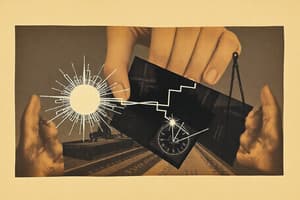Podcast
Questions and Answers
কোন ধরনের শক্তির পরিবর্তন হয় যখন একটি বস্তু উঁচু থেকে নিচে পড়ে?
কোন ধরনের শক্তির পরিবর্তন হয় যখন একটি বস্তু উঁচু থেকে নিচে পড়ে?
- রাসায়নিক শক্তি
- কাইনেটিক শক্তি
- থার্মাল শক্তি
- সম্ভাবনা শক্তি (correct)
কোন আইনের অনুযায়ী একটি বস্তুকে স্থির রাখার জন্য বাহ্যিক বল প্রয়োজন?
কোন আইনের অনুযায়ী একটি বস্তুকে স্থির রাখার জন্য বাহ্যিক বল প্রয়োজন?
- তৃতীয় আইন
- প্রথম আইন (correct)
- চতুর্থ আইন
- দ্বিতীয় আইন
কোন ধরনের চুম্বকত্ব স্থায়ী চুম্বক এবং তড়িৎ প্রবাহের মধ্যে ঘটে?
কোন ধরনের চুম্বকত্ব স্থায়ী চুম্বক এবং তড়িৎ প্রবাহের মধ্যে ঘটে?
- স্থায়ী চুম্বকত্ব
- আপেক্ষিক চুম্বকত্ব
- তড়িৎ চুম্বকত্ব (correct)
- অস্থায়ী চুম্বকত্ব
আলোর প্রতিফলন ঘটে যখন আলো কোন পৃষ্ঠের সংস্পর্শে আসে?
আলোর প্রতিফলন ঘটে যখন আলো কোন পৃষ্ঠের সংস্পর্শে আসে?
কোন আলোক যন্ত্র দ্বারা আমরা অতি সূক্ষ্ম বস্তু পর্যবেক্ষণ করতে পারি?
কোন আলোক যন্ত্র দ্বারা আমরা অতি সূক্ষ্ম বস্তু পর্যবেক্ষণ করতে পারি?
বিদ্যুৎ ক্ষেত্রের শক্তি কত নিউটন প্রতি কুলম্বে পরিমাপ করা হয়?
বিদ্যুৎ ক্ষেত্রের শক্তি কত নিউটন প্রতি কুলম্বে পরিমাপ করা হয়?
বিদ্যুৎ পরিবাহীর প্রতিরোধ কত এককে পরিমাপ করা হয়?
বিদ্যুৎ পরিবাহীর প্রতিরোধ কত এককে পরিমাপ করা হয়?
বিদ্যুৎ বলবিদ্যায় কোন ধরনের শক্তি হল শক্তির হার?
বিদ্যুৎ বলবিদ্যায় কোন ধরনের শক্তি হল শক্তির হার?
বিদ্যুৎ সর্কিটের কোন অংশটি বিদ্যুৎ প্রবাহ করে?
বিদ্যুৎ সর্কিটের কোন অংশটি বিদ্যুৎ প্রবাহ করে?
Flashcards are hidden until you start studying
Study Notes
Electricity
Electric Charge
- Electric charge is a fundamental property of matter
- There are two types of electric charges: positive and negative
- Like charges repel each other, while opposite charges attract each other
Electric Field
- Electric field is a region around a charged particle or object where the force of the charge can be detected
- Electric field lines emerge from positive charges and enter negative charges
- Electric field strength is measured in Newtons per Coulomb (N/C)
Electric Potential
- Electric potential is the potential energy per unit charge at a given point in an electric field
- Electric potential is measured in Volts (V)
- Electric potential difference is the difference in electric potential between two points
- Electric potential difference is also known as voltage
Electric Circuit
- An electric circuit is a path through which electric current flows
- Electric circuit consists of a source of emf (electromotive force), conductors, and loads (resistors)
- Electric circuit can be open or closed
Resistance
- Resistance is the opposition to the flow of electric current
- Resistance is measured in Ohms (Ω)
- Resistance depends on the material, length, and cross-sectional area of the conductor
- Ohm's Law: V = I × R, where V is voltage, I is current, and R is resistance
Electric Power
- Electric power is the rate at which electric energy is transferred
- Electric power is measured in Watts (W)
- Electric power is calculated by the formula: P = V × I
Other Important Topics in SSC Physics
Motion
- Kinematics: study of motion without considering forces
- Dynamics: study of motion considering forces
- Types of motion: rectilinear motion, circular motion, rotational motion, and oscillatory motion
Forces
- Types of forces: contact forces, non-contact forces, gravitational force, frictional force, normal force, and tension force
- Newton's laws of motion:
- First law (inertia): an object at rest remains at rest, and an object in motion remains in motion, unless acted upon by an external force
- Second law (force and acceleration): F = ma, where F is force, m is mass, and a is acceleration
- Third law (action and reaction): every action has an equal and opposite reaction
Energy
- Types of energy: kinetic energy, potential energy, thermal energy, electrical energy, and chemical energy
- Energy conversion: conversion of one form of energy to another
- Law of conservation of energy: energy cannot be created or destroyed, only converted from one form to another
Magnetism
- Magnetic field: a region around a magnet or electric current where the force of the magnet can be detected
- Magnetic field lines emerge from the north pole and enter the south pole
- Types of magnetism: permanent magnetism, electromagnetism, and temporary magnetism
Optics
- Reflection of light: change in direction of light when it hits a surface
- Refraction of light: change in direction of light when it passes from one medium to another
- Lenses: convex lens, concave lens, and plane mirror
- Types of optical instruments: microscope, telescope, and spectrometer
বৈদ্যুতিক বিদ্যা
বৈদ্যুতিক আহ্রণ
- বৈদ্যুতিক আহ্রণ পদার্থের একটি মৌলিক বৈশিষ্ট্য
- বৈদ্যুতিক আহ্রণ দুই ধরনের: ধনাত্মক এবং ঋণাত্মক
- সমআহ্রণ পরস্পর প্রতিহত করে, অন্যদিকে বিপরীত আহ্রণ আকর্ষণ করে
বৈদ্যুতিক ক্ষেত্র
- বৈদ্যুতিক ক্ষেত্র একটি আহ্রণযুক্ত কণা বা বস্তুর চারপাশের অঞ্চল যেখানে আহ্রণের বল শনাক্ত করা যায়
- বৈদ্যুতিক ক্ষেত্র রেখা ধনাত্মক আহ্রণ থেকে উদ্ভূত হয় এবং ঋণাত্মক আহ্রণে প্রবেশ করে
- বৈদ্যুতিক ক্ষেত্রের তীব্রতা নিউটন প্রতি কুলম্ব (N/C) এককে পরিমাপ করা হয়
বৈদ্যুতিক সম্ভাবনা
- বৈদ্যুতিক সম্ভাবনা হল একটি বৈদ্যুতিক ক্ষেত্রের একটি বিন্দুতে প্রতি ইউনিট আহ্রণের সম্ভাবনা শক্তি
- বৈদ্যুতিক সম্ভাবনা ভোল্ট (V) এককে পরিমাপ করা হয়
- বৈদ্যুতিক সম্ভাবনা পার্থক্য হল দুই বিন্দুর মধ্যে বৈদ্যুতিক সম্ভাবনার পার্থক্য
- বৈদ্যুতিক সম্ভাবনা পার্থক্যকে ভোল্টেজও বলা হয়
বৈদ্যুতিক সার্কিট
- বৈদ্যুতিক সার্কিট হল বৈদ্যুতিক প্রবাহের পথ
- বৈদ্যুতিক সার্কিটে একটি আহ্রণ উৎস, পরিবাহী এবং ভার (রোধক) থাকে
- বৈদ্যুতিক সার্কিট খোলা বা বন্ধ হতে পারে
রোধ
- রোধ হল বৈদ্যুতিক প্রবাহের বিরোধ
- রোধ ওহম (Ω) এককে পরিমাপ করা হয়
- রোধ পরিবাহীর উপাদান, দৈর্ঘ্য এবং অনুভূমিক ক্ষেত্রফলের উপর নির্ভর করে
- ওহমের সূত্র: V = I × R, যেখানে V ভোল্ট, I প্রবাহ এবং R রোধ
বৈদ্যুতিক শক্তি
- বৈদ্যুতিক শক্তি হল বৈদ্যুতিক শক্তির স্থানান্তরের হার
- বৈদ্যুতিক শক্তি ওয়াট (W) এককে পরিমাপ করা হয়
- বৈদ্যুতিক শক্তি সূত্র: P = V × I
Studying That Suits You
Use AI to generate personalized quizzes and flashcards to suit your learning preferences.




